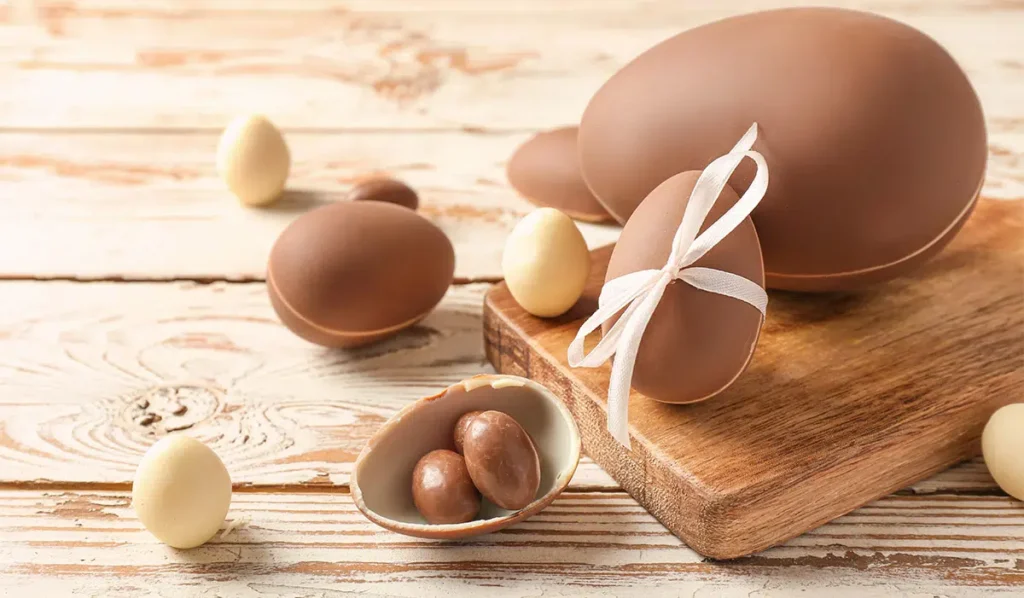No, most of the chocolate doesn’t contain eggs. Furthermore, they don’t include pure chocolate.
But some chocolate products, like certain candies or filled chocolates, might have eggs as part of their ingredients.
Traditional chocolate is made from cocoa solids, cocoa butter, and sugar. However, some chocolate products, like certain bars or candies, might have additional ingredients.
So, it’s always a good idea to check the label if you’re specifically avoiding or hunting for eggs.
Pure Chocolate Composition

Absolutely, let’s break down the basics of chocolate!
Basic Ingredients in Pure Chocolate
Cocoa Solids: This is the essence of chocolate, the stuff that gives it that rich, deep flavor. Cocoa solids are essentially the non-fat part of the cocoa bean that remains after it’s ground and liquefied. They’re responsible for the complex and intense taste of chocolate.
Cocoa Butter: Found naturally in cocoa beans, cocoa butter adds that luxurious melt-in-your-mouth quality to chocolate. It’s the fat content of chocolate and contributes to its smooth texture. Think of it as the secret ingredient that makes chocolate so indulgent.
Sugar: Sweet, sweet sugar. It’s the ingredient that balances out the bitterness of cocoa solids and gives chocolate its delightful sweetness. It’s also the reason we find chocolate so irresistible.
When you have these three basic ingredients in the right proportions, you get pure, unadulterated chocolate.
No Eggs in Traditional Chocolate:
Unlike many baked goods, traditional chocolate recipes don’t call for eggs.
Why? Well, chocolate is all about simplicity and letting the cocoa shine. Eggs bring moisture and structure to baked goods, but we want the pure, unadulterated cocoa experience in chocolate.
Eggs could alter the texture and flavor of chocolate, diluting its intense taste. By leaving them out, chocolate remains a celebration of the cocoa bean’s natural goodness.
No fancy additives, just the simple pleasure of cocoa in its most essential form. It’s like a delicious alchemy of flavors, creating a treat that has stood the test of time. It’s amazing how something so basic can be so incredibly satisfying!
Chocolate Varieties and Fillings
Absolutely, let’s explore the diverse world of chocolate varieties!
Some Chocolate Products with Eggs:
While traditional chocolate itself doesn’t include eggs, certain chocolate products and confections might. For instance, chocolate truffles, pralines, or filled chocolates may contain egg-based fillings or additives.
Examples of Chocolates with Egg-based Fillings:
Chocolate Truffles: These luscious balls of joy often have creamy centers. Some recipes for truffle fillings may include ingredients like ganache, which can contain eggs for a smoother texture.
Pralines: A delicious combination of chocolate and nuts, pralines can sometimes have nougat or creamy fillings that might contain eggs.
Chocolate Mousse-filled Chocolates: Picture biting into a chocolate shell and discovering a velvety chocolate mousse inside. The mousse often gets its airy texture from whipped eggs.
Certain Chocolate Ganache: Not all chocolate ganache recipes include eggs, but some use them for a particular consistency or flavor.
To be sure about eggs in your chocolate treats, it’s wise to check the ingredient list.
But fear not; there are also plenty of egg-free options for chocolate lovers! Is there anything specific you’re craving or curious about in the world of chocolate?
Reading Labels
Importance of Checking Labels:
For anyone with dietary restrictions, checking ingredient labels is like having a superpower—it helps you make informed choices about what you consume.
Labels are your trusty guide to ensuring that what you’re about to enjoy aligns with your dietary needs and preferences.
Furthermore, reading labels is like being a chocolate detective, and it’s a crucial skill when it comes to processed chocolate. Here’s why:
Additives: Some chocolate products may sneak in additives to enhance flavor, texture, or shelf life.
These could be things like emulsifiers, stabilizers, or preservatives. While they might not be harmful, knowing what you’re indulging in is good.
Allergens: Ah, the sneaky ingredients that can cause trouble! Some chocolates might contain allergens like nuts or dairy. Always check for these if you have allergies or dietary restrictions.
Eggs: Eggs might seem like an odd addition to chocolate, but some fancy varieties or artisanal creations might throw them into the mix. It’s not a standard ingredient, but it’s worth keeping an eye out if you have specific dietary requirements.
Tips on Identifying Egg Content in Chocolate:
Look for Specific Ingredients: Check for obvious egg-related terms like “egg,” “egg white,” or “egg yolk.” This is the most direct way to spot eggs in the ingredient list.
Watch for Hidden Egg Sources: Sometimes, eggs might be hidden in other ingredients, like certain emulsifiers or lecithins. If you’re uncertain about an ingredient, a quick online search or checking with the manufacturer can provide clarity.
Allergen Information: Many packaged foods include allergen information in bold or highlighted text. Look for statements like “Contains: Eggs.” This is a quick way to know if the product is safe for you.
Certified Vegan or Allergy-Friendly Labels: Products with these labels are generally safe for those avoiding eggs. They indicate that the product has been carefully formulated to exclude common allergens, including eggs.
Contact the Manufacturer: If you’re still unsure after checking the label, don’t hesitate to reach out to the manufacturer. They often have customer service contacts who can provide detailed information about their products.
White chocolate skips the cocoa solids altogether and focuses on the cocoa butter, sugar, and milk solids.
So, next time you’re eyeing that chocolate bar, take a moment to flip it over and decipher the label. It’s your ticket to understanding what’s really in that sweet treat and making an informed decision about what you want to savor. Happy chocolate hunting!
Common Misconceptions
Eggs and chocolate – it’s like an unexpected culinary pairing, right? Well, the truth is, eggs don’t have a starring role in the world of traditional chocolate.
There’s a common misconception that chocolate inherently contains eggs, but that’s not the case for the classic chocolate bar.
Cocoa Concoction: The core ingredients of chocolate are cocoa solids, cocoa butter, and sugar. Eggs don’t really fit into this trio. In fact, traditional chocolate is often a simple mix of these components, letting the richness of cocoa shine.
Confusing Ingredients: Sometimes, it’s not eggs that are causing the confusion but other ingredients that might sound similar. For instance, lecithin is an emulsifier commonly used in chocolate production.
It helps blend the cocoa solids and cocoa butter smoothly. While lecithin can come from egg yolks, the type used in chocolate production is typically derived from soy or sunflower.
Artisanal Exceptions: When you venture into the world of artisanal or gourmet chocolates, you might encounter unique creations that include eggs for a specific flavor or texture. These are exceptions and not the norm for your everyday chocolate bar.
So, the next time someone insists chocolate contains eggs, you can confidently set the record straight. It’s all about demystifying the chocolate world, one misconception at a time!
Alternatives for Egg-Free Chocolate Lovers

Let’s cater to our egg-free chocolate enthusiasts!
Egg-Free Chocolate Brands:
Enjoy Life Foods: They specialize in allergy-friendly products, including chocolate bars and chips that are free from common allergens, including eggs.
Divvies: This brand is known for its delicious, egg-free chocolates, including chocolate bars and gourmet treats.
No Whey Chocolate: Perfect for those with multiple allergies, No Whey offers a variety of chocolate treats without eggs, dairy, nuts, and gluten.
Always double-check the labels just to be sure, but these brands are a great starting point for egg-free chocolate indulgence.
DIY Egg-Free Chocolate Recipes:
Homemade Chocolate Bark:
- Melt dairy-free chocolate chips (check the label for egg-free options).
- Pour onto a baking sheet and spread it out.
- Sprinkle with your favorite toppings like nuts, dried fruits, or sea salt.
- Let it cool and harden in the fridge, then break it into delicious chunks.
Vegan Chocolate Mousse:
- Whip up aquafaba (the liquid from a can of chickpeas) until it forms stiff peaks.
- Melt your favorite dairy-free chocolate and fold it into the whipped aquafaba.
- Chill the mixture until it sets, and voila—silky, egg-free chocolate mousse.
Fudge Brownies without Eggs:
- Combine flour, sugar, cocoa powder, baking soda, and salt.
- Add oil, water, and vanilla extract to the dry ingredients.
- Mix until smooth, bake, and you’ve got decadent egg-free brownies.
Whether you’re reaching for a ready-made treat or feeling a bit adventurous in the kitchen, plenty of egg-free chocolate options satisfy that sweet tooth.
FAQs
Does pure chocolate contain eggs?
No, pure chocolate is made from cocoa solids, cocoa butter, and sugar and does not include eggs.
Are there chocolate products that may contain eggs?
Yes, some processed chocolate products, like certain bars or candies, might have eggs as additional ingredients. Check the label for accuracy.
What types of chocolate should I avoid if I’m allergic to eggs?
It’s advisable to check labels on chocolate bars, truffles, or filled chocolates, as these may potentially contain eggs.
Can dark chocolate contain eggs?
Pure dark chocolate typically does not contain eggs, but checking the specific product’s ingredients is essential.
Do milk chocolate and white chocolate have eggs?
While milk and white chocolate usually contain milk solids, they may also have added ingredients, so always check the label to confirm the absence of eggs.
Is there a risk of cross-contamination with eggs in chocolate factories?
Cross-contamination is possible in facilities that process both chocolate and egg-containing products. Look for allergy warnings on the packaging if you have concerns.
Can I trust allergen labels on chocolate products?
Yes, allergen labels are designed to inform consumers about the presence of common allergens, including eggs. Always read them carefully.
Are there vegan chocolate options without eggs?
Yes, many vegan chocolate options are egg-free. Look for chocolate labeled as vegan or check the ingredients for egg derivatives.
Are there natural substitutes for eggs in homemade chocolate recipes?
Yes, various egg substitutes like applesauce, mashed bananas, or commercial egg replacers can be used in homemade chocolate recipes.
What chocolate brands are known for being egg-free?
Several chocolate brands explicitly state that their products are egg-free. Look for brands that prioritize transparency about their ingredients.
Can I contact chocolate manufacturers for detailed ingredient information?
Absolutely. If you have specific concerns about eggs in chocolate, contacting the manufacturer can provide the most accurate and up-to-date information.
Conclusion
In the world of chocolate, simplicity is key. The classic trio of cocoa solids, cocoa butter, and sugar forms the heart of traditional chocolate.
Reading labels becomes a skillful act of decoding, uncovering potential additives, and ensuring allergen awareness.
As for the persistent egg myth, rest assured that eggs take a back seat in your regular chocolate bar. It’s a delightful journey through the basics, debunking misconceptions and savoring chocolate’s pure, unadulterated joy. Happy indulging!

